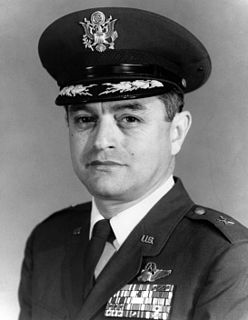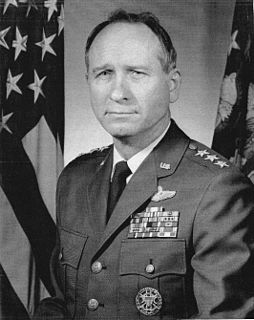
The Distinguished Flying Cross (DFC) is a military decoration of the United States Armed Forces. The medal was established on July 2, 1926, and is currently awarded to any persons who, after April 6, 1917, distinguish themselves by single acts of heroism or extraordinary achievement while participating in aerial flight. Both heroism and extraordinary achievement are entirely distinctive, involving operations that are not routine. The medal may be awarded to friendly foreign military members in ranks equivalent to U.S. Pay Grade of O-6 and below, in actual combat in support operations.

Gordon Aylesworth Blake was a lieutenant general in the United States Air Force who served as Director of the National Security Agency from 1962 to 1965.

Robert Michael "Bob" White was an American electrical engineer, test pilot, fighter pilot, and astronaut. He was one of twelve pilots who flew the North American X-15, an experimental spaceplane jointly operated by the Air Force and NASA. As an engineer, he supervised the design and development of several modern military aircraft.

Brigadier General Frank Kendall "Pete" Everest Jr. was a U.S. Air Force officer who is best remembered as an aeroengineer and test pilot during the 1950s.

Clarence Emil "Bud" Anderson is a retired officer in the United States Air Force, a triple ace of World War II, and the highest scoring living American fighter ace. During the war he was the highest scoring flying ace in his P-51 Mustang squadron. Towards the end of Anderson's two combat tours in Europe in 1944 he was promoted to major at 22, a young age even for a highly effective officer in wartime. After the war Anderson became a well regarded fighter test pilot, and a fighter squadron and wing commander. He served his wing commander tour in combat in the Vietnam War. He retired as a full colonel in 1972, after which he worked in flight test management for McDonnell Douglas. A member of the National Aviation Hall of Fame, Anderson has remained a sought-after speaker at aviation and military events well into his 90s.
Brigadier General Clifford Schoeffler was director of operations and training in the Office of the Deputy Chief of Staff, Operations, Headquarters Strategic Air Command, Offutt Air Force Base, Nebraska. He was a command pilot with more than 10,000 flying hours accumulated during his career.

Albert Francis Hegenberger was a major general in the United States Air Force and a pioneering aviator who set a flight distance record with Lester J. Maitland, completing the first transpacific flight to Hawaii in 1927 as navigator of the Bird of Paradise. Hegenberger was an aeronautical engineer of note, earning both the Mackay Trophy (1927) and Collier Trophy (1934) for achievement.

General Mark Edward Bradley was a United States Air Force general and a pioneering aviator. He served as commander of the U.S. Air Force Logistics Command.

General Benjamin Wiley Chidlaw was an officer in the United States Air Force. He directed the development of the United States' original jet engine and jet aircraft. He joined the United States Army Air Service, at the time a precursor to the United States Air Force (USAF), in 1922 and for several years served in training and engineering positions. By 1940 he was chief of the Experimental Engineering Branch and involved with the development of jet engines. During World War II he was deputy commander of 12th Tactical Air Command and later organised the establishment of the 22nd Tactical Air Command in the European Theater of Operations. After the war he remained in senior command positions and finished his career with the USAF in 1955 as commander in chief of the Continental Air Defense Command with the rank of general. He died in 1977 at the age of 76.

General Jack Joseph Catton was a United States Air Force four-star general and was commander of the Air Force Logistics Command with headquarters at Wright-Patterson Air Force Base and of the Military Airlift Command.

Robert L. "Bob" Cardenas is a retired brigadier general of the United States Air Force.

Fred J. Ascani was an American Major General and test pilot of the United States Air Force. He was one of the "Men of Mach 1" and was considered father of Systems Engineering at Wright Field.

Ennis Clement Whitehead was an early United States Army aviator and a United States Army Air Forces general during World War II. Whitehead joined the U. S. Army after the United States entered World War I in 1917. He trained as an aviator and served in France, where he was posted to the 3d Aviation Instruction Center and became a qualified test pilot. After the war, Whitehead returned to school at the University of Kansas. After he graduated, he was commissioned as a first lieutenant in 1920.

Guy Mannering Townsend III was a retired United States Air Force brigadier general, test pilot, and combat veteran. As an Air Force officer, he served as chief of bomber test at Wright-Patterson Air Force Base, flew as co-pilot on the first flight of the B-52 Stratofortress, was test force director for the XB-70 Valkyrie, and served as program director for the C-5 Galaxy and B-1 Lancer. He was the first military pilot to fly the B-47 Stratojet, B-50 Superfortress, B-52 Stratofortress, and the prototype of the KC-135 Stratotanker. During his years at Boeing, he was the head of the Supersonic Transport operations organization.
Brigadier General Richard W. Fellows (1914–1998) was a United States Air Force officer who served during World War II and the Cold War.
Leslie J. Westberg was a brigadier general in the United States Air Force. He piloted bombers on combat missions in both World War II and the Korean War and reconnaissance aircraft in the Vietnam War.
Hispanics in the United States Air Force can trace their tradition of service back to the United States Army Air Forces (USAAF), the military aviation arm of the United States Army during and immediately after World War II. The USAAF was the predecessor of the United States Air Force, which was formed as a separate branch of the military on September 18, 1947, under the National Security Act of 1947. In the U.S., the term Hispanic categorizes any citizen or resident of the United States, of any racial background, of any country, and of any religion, who has at least one ancestor from the people of Spain or is of non-Hispanic origin but has an ancestor from Mexico, Puerto Rico, Cuba, Central or South America, or some other Hispanic origin. The three largest Hispanic groups in the United States are the Mexican-Americans, Puerto Ricans, and Cubans. According to the U.S. Census Bureau the estimated Hispanic population of the United States is over 50 million, or 16% of the U.S. population, and Hispanics are the nation's largest ethnic minority. The 2010 U.S. Census estimate of over 50 million Hispanics in the U.S. does not include the 3.9 million residents of Puerto Rico, thereby making the people of Hispanic origin the nation's largest ethnic or race minority as of July 1, 2005.

Ray Benjamin Sitton was an American lieutenant general, command pilot and navigator. He was Director of the Joint Staff, Organization of the Joint Chiefs of Staff, Washington, D.C.

John Landrum Martin Jr. was a major general in the United States Air Force. He enlisted in the United States Army Air Corps in 1940 and flew combat missions in Boeing B-29 Superfortress bombers in the China-Burma-India Theater.

James Thompson Stewart was a lieutenant general in the United States Air Force (USAF). He entered the United States Army Air Corps in 1941, and flew two combat tours in Europe as commander of the 508th Bombardment Squadron during World War II. He served with the Far East Air Force in the Korean War, and was staff director of the National Reconnaissance Office and the vice director of the Manned Orbiting Laboratory.
















